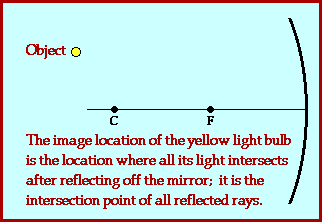Image Formation for Concave Mirrors - Case A
To view an object in any type of mirror, a person must sight along a line at the image of the object. All persons capable of seeing the image must sight along a line of sight directed towards the precise image location. As a person sights in a mirror at the image of an object, there will be a reflected ray of light coming from the mirror to that person's eye. The origin of this light ray is the object. A multitude of light rays from the object are incident on the mirror in a variety of directions; yet as you sight at the image, only a small portion of the many rays will reflect off the mirror and travel to your eye. To see an object in a mirror, you must sight at the image; and when you do reflected rays of light will travel from the mirror to your eye along your line of sight.
Not all people who are viewing the object in the mirror will sight along the same geometrical line of sight. The precise direction of the sight line depends on the location of the object, the location of the person, and the type of mirror. Yet all of the lines of sight, regardless of their direction, will pass through the image location. In fact, the image location is defined as the location where reflected rays intersect. Since all people see a reflected ray of light as they sight at an image in the mirror, then the image location must be the intersection point of these reflected rays.

In the animation above, an object is positioned above the principal axis of a concave mirror and somewhere beyond the center of curvature (C). The concave mirror will produce an image of the object which is inverted (positioned below the principal axis) and located between the center of curvature (C) and the focal point (F) of the mirror. Any person viewing this image must sight at this image position. The animation depicts the path of light to each person's eye. Different people are sighting in different directions; yet each person is sighting at the same image location. As seen in the animation, the image location is the intersection point of all the reflected rays.
For more information on the ray nature of light, visit The Physics Classroom Tutorial. Detailed information is available there on the following topics:
Why is an Image Formed?
The Anatomy of a Curved Mirror
Reflection of Light and Image Formation
Two Rules of Reflection for Concave Mirrors
Ray Diagrams - Concave Mirrors
Image Characteristics for Concave Mirrors
The Mirror Equation - Concave Mirrors